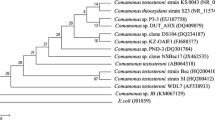Abstract
Several denitrifying Pseudomonas spp., isolated with various aromatic compounds, were tested for the ability to degrade toluene in the absence of molecular oxygen. Four out of seven strains were able to degrade toluene in the presence of N2O. More than 50% of the 14C from ring-labelled toluene was released as CO2, and up to 37% was assimilated into cell material. Furthermore it was demonstrated for two strains that they were able to grow on toluene as the sole carbon and energy source in the presence of N2O. Suspensions of cells pre-grown on toluene degraded toluene, benzaldehyde or benzoate without a lag phase and without accumulation of intermediates. p-Cresol, p-hydroxybenzylalcohol, p-hydroxybenzaldehyde or p-hydroxybenzoate was degraded much slower or only after distinct lag times. In the presence of fluoroacetate [14C]toluene was transformed to [14C]benzoate, which suggests that anaerobic toluene degradation proceeds through oxidation of the methyl side chain to benzoate.
Similar content being viewed by others
References
Dangel W, Brackmann R, Lack A, Magdy M, Koch J, Oswald B, Seyfried B, Tschech A, Fuchs G (1991) Differential expression of enzyme activities initiating anoxic metabolism of various aromatic compounds via benzoyl-CoA. Arch Microbiol 155: 256–262
Dolfing J, Zeyer J, Binder-Eicher P, Schwarzenbach RP (1990) Isolation and characterization of a bacterium that mineralizes toluene in the absence of molecular oxygene. Arch Microbiol 154: 336–341
Evans PJ, Mang DT, Young LY (1991a) Degradation of toluene and m-xylene and transformation of o-xylene by denitrifying enrichment cultures. Appl Environ Microbiol 57: 450–454
Evans PJ, Mang DT, Kim KS, Young LY (1991b) Anaerobic degradation of toluene by a denitrifying bacterium. Appl Environ Microbiol 57: 1139–1145
Fishbein L (1985) An overview of environmental and toxicological aspects of aromatic hydrocarbons. II. Toluene. Sci Total Environ 42: 267–288
Gibson DT, Subramanian V (1984) Microbial degradation of aromatic hydrocarbons. In: Gibson DT (ed) Microbial degradation of organic compounds. Marcel Dekker, New York, pp 181–252
Glöckler R, Tschech A, Fuchs G (1989) Reductive dehydroxylation of p-hydroxybenzoyl-CoA to benzoyl-CoA in a denitrifying, phenol-degrading Pseudomonas species. FEBS Lett 251: 237–240
Grbić-Galić D, Vogel TM (1987) Transformation of toluene and benzene by mixed methanogenic cultures. Appl Environ Microbiol 53: 254–260
Herbert D, Phipps PJ, Strange RE (1971) Determination of protein with the Folin-Ciocalteau reagent. In: Norris JR, Ribbons DW (eds) Methods in microbiology, vol. 5B. Academic Press, London New York, pp 249–252
Jüttner F (1990) Distribution of toluene in stratified lakes and river dams of Southwest Germany. Verh Int Verein Limnol 24: 279–281
Jüttner F, Henatsch JJ (1986) Anoxic hypolimnion is a significant source of biogenic toluene. Nature 323: 797–798
Kuhn EP, Colberg PJ, Schnoor JL, Wanner O, Zehnder AJB, Schwarzenbach RP (1985) Microbial transformations of substituted benzenes during infiltration of river water to groundwater: laboratory column studies. Environ Sci Technol 19: 961–968
Kuhn EP, Zeyer J, Eicher P, Schwarzenbach RP (1988) Anaerobic degradation of alkylated benzenes in denitrifying laboratory aquifer columns. Appl Environ Microbiol 54: 490–496
Lovley RD, Lonergan DJ (1990) Anaerobic oxidation of toluene, phenol and p-cresol by the dissimilatory iron-reducing organisms, GS-15. Appl Environ Microbiol 56: 1858–1864
Schnell S, Schink B (1991) Anaerobic aniline degradation via reductive deamination of 4-aminobenzoyl-CoA in Desulfobacterium anilini. Arch Microbiol 155: 183–190
Seyfried B, Tschech A, Fuchs G (1991) Anaerobic degradation of phenylacetate and 4-hydroxyphenylacetate by denitrifying bacteria. Arch Microbiol 155: 249–255
Smolenski WJ, Suflita JM (1987) Biodegradation of cresol isomers in anoxic aquifers. Appl Environ Microbiol 53: 710–716
Tschech A, Fuchs G (1987) Anaerobic degradation of phenol by pure cultures of newly isolated denitrifying pseudomonads. Arch Microbiol 148: 213–217
Tschech A, Fuchs G (1989) Anaerobic degradation of phenol via carboxylation to 4-hydroxybenzoate: in vitro study of isotope exchange between 14CO2 and 4-hydroxybenzoate. Arch Microbiol 152: 594–599
Wilson BH, Smith GB, Rees JF (1986) Biotransformations of selected alkylbenzenes and halogenated aliphatic hydrocarbons in methanogenic aquifer material: a microcosm study. Environ Sci Technol 20: 997–1002
Zeyer J, Kuhn EP, Schwarzenbach RP (1986) Rapid microbial mineralization of toluene and 1,3-dimethylbenzene in the absence of molecular oxygen. Appl Env Microbiol 52: 944–947
Author information
Authors and Affiliations
Rights and permissions
About this article
Cite this article
Schocher, R.J., Seyfried, B., Vazquez, F. et al. Anaerobic degradation of toluene by pure cultures of denitrifying bacteria. Arch. Microbiol. 157, 7–12 (1991). https://doi.org/10.1007/BF00245327
Received:
Accepted:
Issue Date:
DOI: https://doi.org/10.1007/BF00245327



